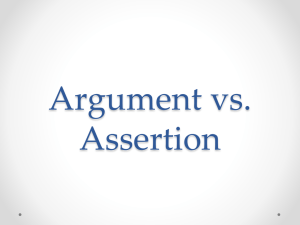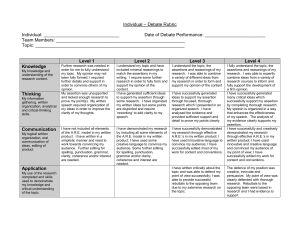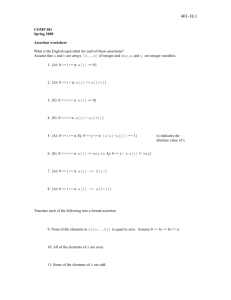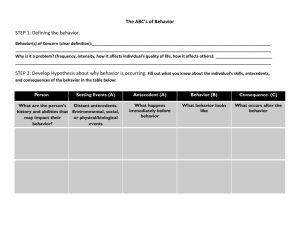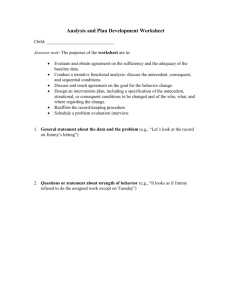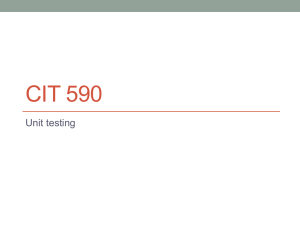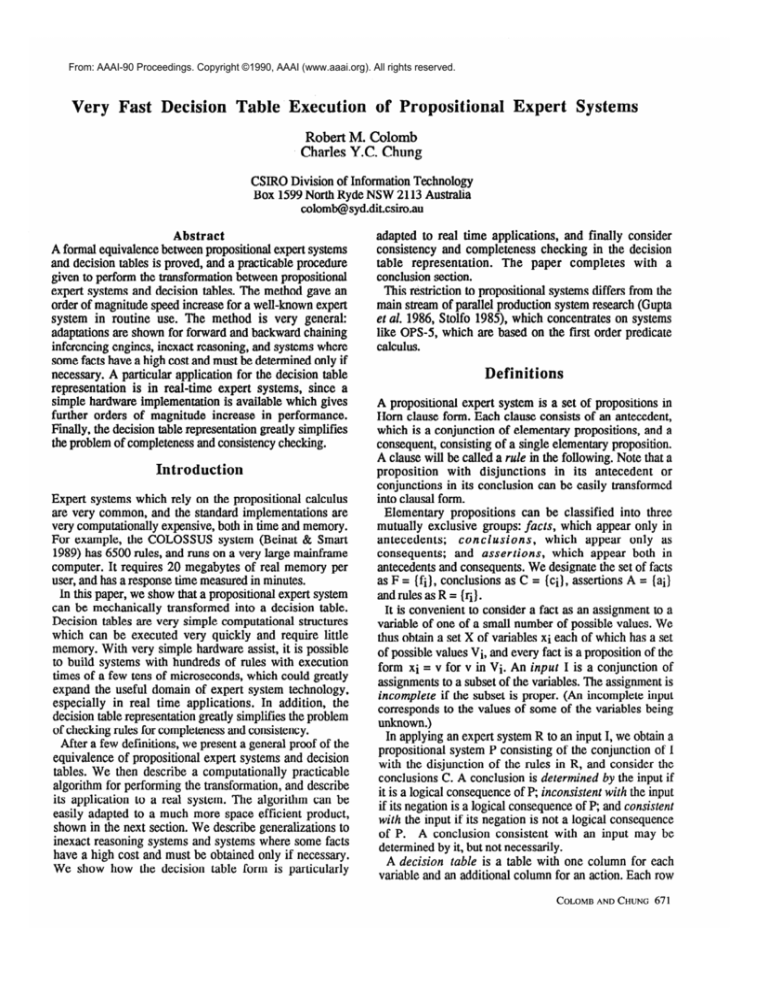
From: AAAI-90 Proceedings. Copyright ©1990, AAAI (www.aaai.org). All rights reserved.
Very Fast Decision
Table Execution
of Propositional
Expert Systems
Robert M. Colomb
Charles Y.C. Chung
CSIRO Division of Information Technology
Box 1599 North Ryde NSW 2113 Australia
colomb@syd.dit.csiro.au
Abstract
A formal equivalence between propositional expert systems
and decision tables is proved, and a practicable procedure
given to perform the transformation between propositional
expert systems and decision tables. The method gave an
order of magnitude speed increase for a well-known expert
system in routine use. The method is very general:
adaptations are shown for forward and backward chaining
inferencing engines, inexact reasoning, and systems where
some facts have a high cost and must be determined only if
necessary. A particular application for the decision table
representation is in real-time expert systems, since a
simple hardware implementation is available which gives
further orders of magnitude increase in performance.
Finally, the decision table representation greatly simplifies
the problem of completeness and consistency checking.
Introduction
Expert systems which rely on the propositional calculus
are very common, and the standard implementations are
very computationally expensive, both in time and memory.
For example, the COLOSSUS system (Beinat & Smart
1989) has 6500 rules, and runs on a very large mainframe
computer. It requires 20 megabytes of real memory per
user, and has a response time measured in minutes.
In this paper, we show that a propositional expert system
can be mechanically transformed into a decision table.
Decision tables are very simple computational structures
which can be executed very quickly and require little
memory. With very simple hardware assist, it is possible
to build systems with hundreds of rules with execution
times of a few tens of microseconds, which could greatly
expand the useful domain of expert system technology,
especially in real time applications. In addition, the
decision table representation greatly simplifies the problem
of checking rules for completeness and consistency.
After a few definitions, we present a general proof of the
equivalence of propositional expert systems and decision
tables. We then describe a computationally practicable
algorithm for performing the transformation, and describe
its application to a real system. The algorithm can be
easily adapted to a much more space efficient product,
shown in the next section. We describe generalizations to
inexact reasoning systems and systems where some facts
have a high cost and must be obtained only if necessary.
We show how the decision table form is particularly
adapted to real time applications, and finally consider
consistency and completeness checking in the decision
table representation.
The paper completes with a
conclusion section.
This restriction to propositional systems differs from the
main stream of parallel production system research (Gupta
et al. 1986, Stolfo 1985), which concentrates on systems
like OPS-5, which are based on the first order predicate
calculus.
Definitions
A propositional expert system is a set of propositions in
Horn clause form. Each clause consists of an antecedent,
which is a conjunction of elementary propositions, and a
consequent, consisting of a single elementary proposition.
A clause will be called a rule in the following. Note that a
proposition with disjunctions in its antecedent or
conjunctions in its conclusion can be easily transformed
into clausal form.
Elementary propositions can be classified into three
mutually exclusive groups: facts, which appear only in
antecedents;
conclusions,
which appear only as
which appear both in
consequents; and assertions,
antecedents and consequents. We designate the set of facts
as F = (fi}, conclusions as C = (ci), assertions A = {ai}
andrules as R = (ri}.
It is convenient to consider a fact as an assignment to a
variable of one of a small number of possible values. We
thus obtain a set X of variables xi each of which has a set
of possible values Vi, and every fact is a proposition of the
form Xi = v for v in Vi. An input I is a conjunction of
assignments to a subset of the variables. The assignment is
incomplete if the subset is proper. (An incomplete input
corresponds to the values of some of the variables being
unknown.)
In applying an expert system R to an input I, we obtain a
propositional system P consisting of the conjunction of I
with the disjunction of the rules in R, and consider the
conclusions C. A conclusion is determined by the input if
it is a logical consequence of P, inconsistent with the input
if its negation is a logical consequence of P, and consistent
with the input if its negation is not a logical consequence
of P. A conclusion consistent with an input may be
determined by it, but not necessarily.
A decision table is a table with one column for each
variable and an additional column for an action. Each row
COLOMBAND~HUNG
671
of the table contains an assignment of values to variables
and an associated action. An incomplete assignment is
equivalent to a don’t care condition for the variables
without values. A decision table is executed by presenting
it with an assignment I. If any row is a subset of I, its
action is executed.
Equivalence
Between Propositional
Expert Systems and Decision Tables
A decision
table is a propositional
expert
system. The assignment in a row is a conjunction of
propositions, which is the antecedent of a rule. The action
of a row is a conclusion. A row is therefore equivalent to a
rule, and a collection of rules is a propositional expert
system by definition. Note that the propositional system
has only facts and conclusions, but no assertions. Such a
system will be called a flat expert system and is clearly
equivalent to a decision table.
A propositional
expert system is a decision
table. Consider an expert system R with an input I.
Associate with I the subset of conclusions determined from
the propositional system P given by the conjunction of I
with the disjunction of rules in R. Call this subset R(1).
R(1) can always be computed since the propositional
calculus is decidable. R can thereby be seen as a function
mapping the set of assignments into the set of subsets of
conclusions. The number of possible assignments is finite.
The function can in principle be expressed in an
extensional form by writing down each assignment I as a
row in a table and appending to it the subset of conclusions
R(1). This form is by definition a decision table.
This proof is constructive,
but unfortunately
not
practicable, since the number of assignments is exponential
in the number of variables. It is, however, general. In
particular, it is independent of the inference engine used and
of the details of any rules involving assertions.
A Practicable
Transformation
Algorithm
This section presents a practicable transformation
algorithm, first by making some restrictive assumptions. It
is then shown how the algorithm can be modified to
remove many of the restrictions.
The restrictive
assumptions are that the system uses a forward chaining
inference engine, and that no assertion is negated in either
an antecedent or consequent of a rule.
We consider the rules ri in the expert system R as nodes
in a graph. An arc is drawn between ri and rj if there is an
assertion a which appears as the consequent of ri and in the
antecedent of rj . We assume that this graph is acyclic: no
proposition is a consequent of a rule of which it is an
antecedent, or more generally, no proposition is a
consequent of a rule which has an antecedent necessarily
logically dependent on it. This graph is essentially the
dependency graph of Nguyen, et al. (1985).
We partition the set of rules into B, those all of whose
antecedents are facts; K, those whose consequents are
conclusions; and M, the others. (B and K are assumed
672
KNOWLEDGEREPRESENTATION
disjoint. Any rules in B intersect K are flat by definition,
so can be removed and added to the flat expert system
produced by the algorithm after its completion.) A node r
can be labelled by the maximum number of arcs between it
and a member of B, as shown in Figure 1. B is the set with
label 0, and M can be partitioned into Ml, M2, etc. each
Mi consisting of the nodes with label i. The label of K is
defined as the maximum depth of reasoning of the system
R. As shown in the figure, we also label each arc with the
assertion from which the arc is derived and each assertion
with the maximum label of a node with that assertion as a
consequent. This labelling can be done in the course of
verifying that the graph has no cycles using an algorithm
successively removing nodes with no input arcs.
3
Figure 1
Graphical Representation of Rules
Labelled by Distance From Base
Lemma 1: Every assertion in an antecedent of a rule of
label i must have a label less than i. Proof follows directly
from the definitions.
Lemma 2: There is at least one rule with every label up
to the maximum depth of reasoning. Proof: if a level i
were missing, then in the acyclic verification process when
step i were reached there would be no nodes without input
arcs and the graph would therefore be cyclic.
The algorithm proceeds by replacing each assertion a in
the antecedents of rules labelled i with the disjunction of
the antecedents of rules in labelled i-l of which Vassertiona
is a consequent, beginning with label 1. This process in
effect collapses the rules onto the conclusions by
successively replacing intermediate assertions with
expressions which imply them. The resulting propositions
have only facts in their antecedents and only conclusions as
consequents, can be expressed in clausal form, therefore
form a flat expert system and therefore are equivalent to a
decision table.
A detailed presentation of the algorithm with a worked
example is given in Colomb (1989).
The assumptions can be relaxed.
Analysis
of Algorithm
The algorithm
of a labelled
decision table
table of rules.
can be divided into two parts: construction
dependency graph, and production of the
from the labelled graph. We begin with a
An auxiliary data structure is required: an
ahernatives cozm, which will contain for each assertion the
number of rules having that assertion as consequent. The
dimensions of the problem will be:
r
the number of rules
a
the average number of assertions per rule
the maximum depth of reasoning
d
To construct the dependency graph, we first count the
number of alternatives for each assertion. This requires one
step per rule, therefore is O(r). Facts will be taken as
having zero alternatives. We then proceed to identify the
rules with label I, which are those rules all of whose
antecedents have zero alternatives. When a rule is labelled,
we decrement the number of alternatives for its consequent
assertion, and also record a pointer to the rule in a data
structure associated with the assertion. This step requires
examination of each antecedent in each rule, and is therefore
O(ar). At the end of the step, additional assertions have a
zero alternative count (follows from lemma 2). The graph
can be completely constructed and labelled in one step for
each possible label, bounded by the maximum depth of
reasoning. Construction of the labelled dependency graph is
therefore O(ard).
Production of the decision table is done by repeated
traversal of sections of the dependency graph. The cost of a
single traversal is highly dependent on the details of data
representation, but requires at most examination of each
antecedent in each rule, therefore is at most O(ar). One
traversal is required for each row in the resulting decision
table. It is therefore necessary to estimate the number of
rows.
There will certainly be one row in the decision table for
each rule whose consequent is a conclusion. Additional
rows will arise from alternative paths for satisfying the
antecedents of one of these terminaI rules. An alternative
arises if one of its antecedents is the consequent of more
than one rule. It follows that the number of rows is equal
to the number of terminal rules if the alternatives count is
I for each assertion, and that the number of rows increases
in a complex multiplicative way as the aZternatives counts
become greater than I.
The problem is the same as converting an arbitrary
boolean expression into disjunctive normal form. For
example
(a + b & (c + d)) & (e + f)
converts to
a&e+b&c&e+b&d&e+
a&f+b&c&f+b&d&f
We can compute the number of rows during the
construction and labelling of the dependency graph. We
need an additional data structure fuZZ alternative counts
paralleling the alternative counts, having one entry for each
assertion, and also for each conclusion. For a particular
assertion, the latter is the number of rules having that
assertion as consequent, while the former will be the
number of disjuncts in the disjunctive normal form
expression which implies that assertion starting from facts
only. Full azternative count is a sort of transitive closure
ofalternative
count, and is initially 0. A fact has full
alternative count of 3.
When a rule is labelled, the furl alternative count
associated with its consequent is increased by the product of
the full alternative counts of its antecedents. The total
number of rows in the decision table is the total of the fuZZ
alternative counts of all the conclusions.
If IV is the number of rows, then the production of the
decision table at most O(Nar). This step will tend to
dominate the computation time.
Backward
Chaining
The basic algorithm given above is based on a forward
chaining inference engine, which starts with known facts
and derives conclusions as the antecedents of rules become
known. If the rules labelled n are identified as layer n, This
corresponds to a traversal of the dependency graph starting
from layer 1. This traversal will tend to be layer by layer,
necessarily so if negation by failure is employed. We will
call the labels and layers obtained in the forward chaining
approach asforward labels and layers, respectively.
An alternative way to inference is to start from the rules
with conclusions as consequents and work backwards,
called backward chaining. If the inference engine is
backward chaining, we note that a graph can be verified
acyclic by successively removing nodes with no output arc.
The dependency graph can therefore be labelled with
minimum distance from K rather than from maximum
distance from B, and the algorithm modified accordingly.
The maximum depth of reasoning d is clearly unchanged.
These labels will be called backward labels.
Note that if a node has backward label i it must have
forward label less than d - i. This follows from the
observation that step d of the backward algorithm removes
nodes with no input arc. The backward collapse therefore
has the same result as the forward collapse since it can be
performed by the forward collapse algorithm on the graph
with the backward labelling.
Under the assumptions made so far, forward and backward
chaining have exactly the same result, obtained in the
forward chaining case by collapsing the dependency graph
from the facts onto the conclusions through the assertions.
In the backward chaining case, the assertions are subgoals,
and the algorithm coliapses the graph from the conclusions
onto the facts through the subgoals. The two strategies can
COLOMBANDCHUNG
673
be viewed as alternative ways of constructing the function
mapping the set of assignments into the set of subsets of
conclusions.
Negated
Assertions
in Antecedents
We assume that the inference engine does not evaluate a
rule with a negated assertion in its antecedent until it has
evaluated all rules with that assertion as consequent. Since
no rule has a negated assertion as a consequent, the
inferencing must rely on the closed world assumption for
negation.
Let r be such a rule and let i be the maximum forward
label of any negated assertion in its antecedent. Rule r is
labelled with the maximum of i and the label of any unnegated assertion in its antecedent. When rule r is reached
in the forward collapse algorithm, any negated assertion is
replaced by the negation of the expression implying that
assertion.
Negated
Assertions
as Consequents
In a system where negated assertions are allowed as
consequents, the closed world assumption is not needed. An
assertion and its negation are in most respects separate
propositions and can be treated as such, with two
exceptions. First, the negation of an assertion can not label
any arc leading from the base set to a rule for which that
assertion is a consequent. Second, any input which would
imply both the assertion and its negation is forbidden. The
algorithm in its course identifies an expression in facts
which implies each proposition. If we have for assertion a
El ->a; E2->nota;
then a valid input must be consistent with
no@1 and E2)
Test Case
The algorithm has been successfully applied to the Garvan
ES1 thyroid assay system (Buchanan 1986), which has
been in routine use since 1984. It has 600 rules, and an
average depth of reasoning of about 4. Some of the rules
have negated assertions in their premises, but no rule
asserts a negation. The system normally runs on a PDP-11
with a specialized inference engine. For purposes of
comparison, it was translated into OPS-5 and run on a
Microvax II, where it operates at about 18 rule firings per
second, taking about 220 milliseconds to generate a
conclusion. It was transformed into a decision table with
5300 rows. There are 34 variables with a total of 93
possible values, so the decision table requires 5300 x 93
bits, or about 62k bytes of memory.
There are a number of ways to process a decision table.
One is to convert it into a decision tree, using methods like
ID3 (Quinlan 1982). This approach is presently under
investigation. A balanced decision tree with N leaves
identifies a particular leaf in log20 decisions, so that a
table with 4096 rows would be computed in 12 decisions,
each of which is a simple if...then
statement. This
674
KNOWLEDGEREPRESENTATION
approach would clearly be extremely fast on standard
hardware. In addition, there is evidence that the decision
table can be considerably reduced, also the subject of
continuing research.
Execution results presented here are from a method using
an inexpensive bit-serial content-addressable memory
(Colomb & Allen 1989) acting as a co-processor on a Sun
3/160. It is capable of processing a decision table at a rate
of about 100 million bits per second, and can compute a
decision from the transformed Garvan ES1 in about 2
milliseconds. The processor used has a programming model
similar to the MasPar, Distributed Array Processor, and the
Connection
Machine, all of which are commercially
available fine-grained parallel machines. The MasPar, for
example, would be able to execute the system in about 20
microseconds.
We can conclude from this that it is possible to transform
a general propositional expert system into a form that is
capable of execution in a time sufficiently short that it
opens many possibilities for the use of expert systems in
real time applications.
Generalizations
There are a number of practical issues in expert systems
engineering which are not addressed by the preceding
results. These include explanation capability, obtaining
expensive facts only when necessary, and inexact
reasoning. The results can be generalized to deal with all of
these issues.
Explanation
Capability
An important feature of expert systems is the ability to
explain a conclusion or the reasons for asking a particular
question. Most approaches to explanation follow the chain
of assertions between the base facts and the conclusion, so
are derived from the trace of the traversal of the dependency
graph.
In practice, many expert systems do not use explanations
in their normal execution. (Garvan ES 1, for example, is a
batch program.) Jansen & Compton (1988) make a strong
case for the separation of the normal execution
environment where explanations are not available from a
maintenance
environment
where a very complete
explanation environment is provided
In any case, it is possible to adapt the main results to
give an efficient computation structure which permits a
complete explanation capability. Rather than a decision
table, this approach relies on executing the rules in
sequence in a single pass.
Recall that the algorithm labels each rule with the
maximum number of inference steps between it and the
base facts. From lemma 1, all antecedents of rules at level i
are determined by rules of level less than i. In addition,
rules at the same level can be evaluated in any order.
Clearly, if the rules are sorted by level, it is possible to
execute them in a single pass. It is only necessary to keep
a table of the value of each of the assertions (initialized to
fake if the closed world assumption is used) which is
updated by any rule firing whose consequent makes that
assertion. Since no assertion found in the antecedent of a
rule can be changed by any subsequent rule, a complete
explanation capability is available. For example, if the
question is “why did a particular rule not fire?“, the table of
assertions will contain the values of all the antecedents of
that rule at the time it was considered. A further
explanation can be obtained in a similar way be examining
the rules in earlier layers which have a particular assertion
as consequent.
One way to represent this system is as a decision table
with one row per rule and one column for each possible
value of each fact augmented by one column for each
possible value for each assertion. The Garvan system noted
above can be represented as a decision table with 600 rows.
There are 52 assertions, so 104 columns are needed besides
the 93 required for the 34 fact variables, so that 600 x (104
+ 93) bits or about 15k bytes are needed for its storage,
considerably less than the 62k bytes needed for the fully
expanded decision table.
The Knowledge Dictionary of Jansen & Compton (1988)
has been re-implemented
with an inference engine
employing the method of this section (Lee, 1990). Note
that the Garvan ES1 inference engine (Horn et al. 1985)
takes essentially this approach to get fast execution on a
PDP-11 with limited memory. Their approach can now be
seen to be quite general.
Expensive
Advantages
of Decision
Representation
Table
Facts
The previous results make the implicit assumption that all
facts are available at the beginning of inference, and all
facts have equal cost. In practice, some facts may have a
high cost, perhaps because they require database access or
questioning the user. In this case, it is usual to first make
use of the inexpensive facts available at the beginning,
obtaining the expensive facts only if necessary. There will
usually be rules whose consequent is not an assertion, but
a command to assign values to a group of variables.
The set of facts can be labelled in the same way as the
assertions, with facts available immediately labelled zero.
In the decision table representation, the row headings can
be sorted in increasing order of label. If the table is
processed left to right, by the time a column labelled one
or more is reached, the conditions under which that column
is needed would be able to be evaluated. In the single-pass
representation, the rule whose consequent is to obtain these
facts will be in its correct place in the sequence.
Note that in this case the choice of forward or backward
chaining affects the sequence in which expensive facts are
obtained, since the dependency graph is traversed in a
different order. This order is preserved in the sequence of
column headings in the resulting decision table or in the
sequence of rules in the single pass version.
Inexact
although insufficient research has been conducted to
determine the practicality of the method.
First, an uncertainty measure can be appended to each
proposition. An assignment of values to variables would
also assign an uncertainty measure. The subset of
conclusions would also have uncertainty measures. The
main theorem still holds.
Second, in the forward chaining algorithm, the
uncertainty measure can be propagated as a tree of function
composition. For example, if u(x) is the uncertainty of
proposition x, we might have
a&b->c
u(c) = f(u(a), u(b))
c&d-Be
u(e) = f(u(c), u(d>)
then we would have
u(e) = f(fo,
u(b)), u(d))
If the uncertainty propagation function is associative, it is
not necessary to record the tree of inferences by which the
assertions are eliminated, and the uncertainty of a
conclusion can be computed directly from the uncertainties
of the base facts in its antecedent.
In particular, the commonly employed Bayesian measure
of uncertainty is a priori independent of the intermediate
assertions, since the joint probability of conclusions and
base facts is known in principle independently of the
reasoning system.
Reasoning
Some expert systems use one or another form of inexact
reasoning. The result can be adapted to this situation,
Representation of an expert system as a decision table has
advantages apart from the possibility of faster execution.
Real Time
The main impact of these results on real-time systems is
that execution time is not only much faster than
conventional implementations, but it is also bounded. If
the decision table is converted into a decision tree, the
maximum number of decisions is known. If the decision
table is processed directly by a fine-grained parallel
processor, the maximum number of column operations
needed is known.
A secondary benefit, particularly when the decision table
is processed directly using a fine-grained parallel processor,
comes from the fact that in real time situations facts are
sometimes available asynchronously. In the decision table
representation, it is very simple to compute the set of
conclusions consistent with any assignment, no matter
how incomplete. If we collect facts as they become
available into what can be called a current assignment, we
can always associate with the current assignment the set of
conclusions consistent with it. Of course, we can in
particular note the conclusions determined by the current
assignment.
There might be a subset of conclusions considered to be
important for some reason. It would be easy to monitor
whether any important conclusions were consistent with
the current assignment, for example. The possibility of one
of these might trigger some additional measurements.
COLOMBANDCHUNG
675
When a measurement is made which conflicts with a fact
in the current assignment, the associated conclusions of the
new current assignment can be computed quickly, perhaps
making complex truth maintenance algorithms less
necessary.
Rule Induction
Since propositional expert systems are equivalent to
decision tables, it is more plausible that rule induction
methods which build decision trees from examples (e.g
Quinlan 1986), are generally applicable.
Consistency
and
Completeness
The decision table representation is much easier to test for
consistency and completeness. The methods advocated by
e.g. Cragun & Steudel (1987) are seen to be generally
applicable.
Conclusion
The equivalence of propositional expert systems and
decision tables has been shown, and a practicable algorithm
presented for transforming an expert system into a decision
table. The algorithm has been successfully tested on a
substantial system of real utility. The method is capable of
generalization to accommodate many of the practical
problems encountered in practice, and makes consistency
and completeness checking much easier. A particular
consequence is that the computation time for these systems
can be reduced by orders of magnitude, potentially greatly
increasing the applicability of expert systems technology
especially for real time problems.
Acknowledgements
Thanks to the referees for their helpful suggestions.
References
Beinat, P. & Smart, R. (1989) COLOSSUS: Expert
Assessor of Third Party Claims Fifth Australian
Conference on Applications of Expert Systems Sydney,
Australia, pp. 70-85.
Buchanan, B. (1986) Expert Systems: Working Systems
and Research Literature Expert Systems 3( 1): 32-5 1.
Colomb, R.M. (1989) Representation of Propositional
Expert Systems as Decision Tables Third Joint Australian
Artificial Intelligence Conference (Al’89) Melbourne,
Victoria, Australia.
Colomb, R.M. & Allen, M.W. (1989) Architecture of the
Column Computer Conference on Computing Systems and
Technology,
Institution of Engineers,
Information
Australia.
676 KNOWLEDGEREPRESENTATION
Cragun, B.J. & Steudel, H.J. (1987) A Decision-TableBased Processor for Checking Completeness
and
Consistence in Rule-Based Expert Systems International
Journal of Man-Machine Studies 26(5):633-648.
Gupta, A., Forgy C., Newell, A, & Wedig, R. (1986)
Parallel Algorithms and Architectures for Rule-Based
Systems 13th Annual International Symposium on
Computer Architecture IEEE, 28-37.
Horn, K.A., Compton, P., Lazarus, L., & Quinlan, J.R.
(1985) An Expert Computer System for the Interpretation
of Thyroid Assays in a Clinical Laboratory Australian
Computer Journal 17(1):7-l 1.
Jansen, R. & Compton, P. (1988) The Knowledge
Dictionary: An Application of Software Engineering
Techniques to the Design and Maintenance of Expert
Systems AAAI-88 Workshop on Integration of Knowledge
Acquisition and Performance Systems, Minnesota USA.
Lee, M. R.-Y. (1990) The Implementation of a Knowledge
Dictionary in SQL Technical Report TR-FD-90-02 CSIRO
Division of Information Technology, Sydney Australia.
Nguyen, T.A., Perkins, W.A., Laffey, T.J., & Pecora, D.
(1985) Checking an Expert System Knowledge Base for
Consistency and Completeness” IJCAI-85
Morgan
Kaufman.
Quinlan, J.R. (1982) Semi-Autonomous Acquisition of
Pattern Based Knowledge, in Hayes, J.E., Michie, D., and
Pao, Y-H, eds, Machine Intelligence 10, Ellis Horwood,
159-172.
Quinlan, J.R. (1986) Induction of Decision Trees Machine
Learning l(1): 81-106.
Stolfo, S.J. (1985) On the Design of Parallel Production
System Machines: What’s in a LIP? Proceedings 18th
Hawaii International Conference on System Science.

